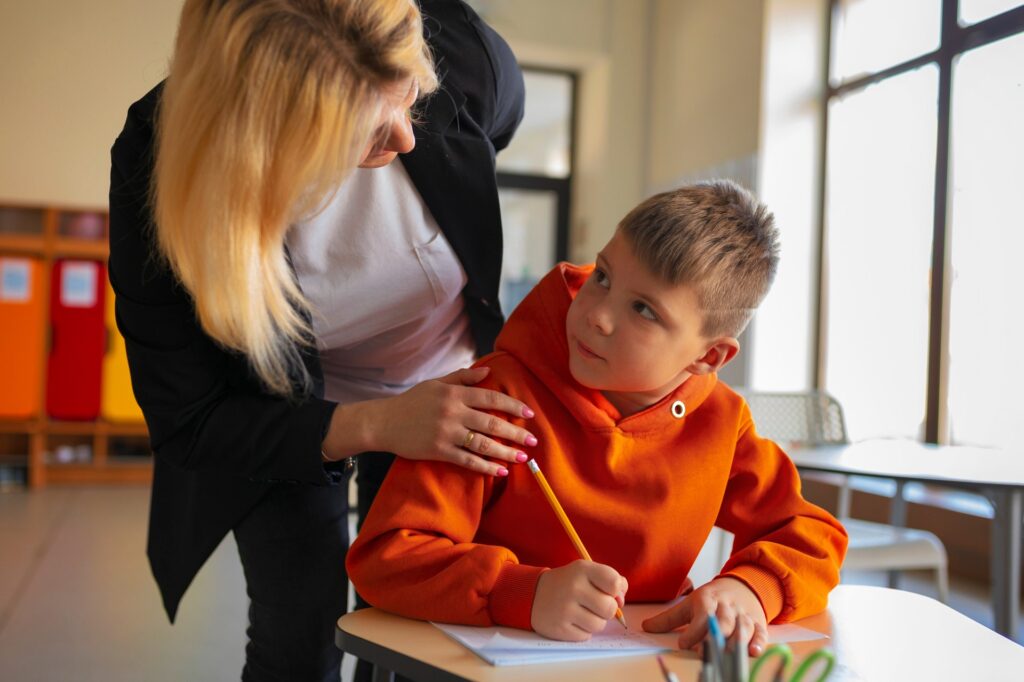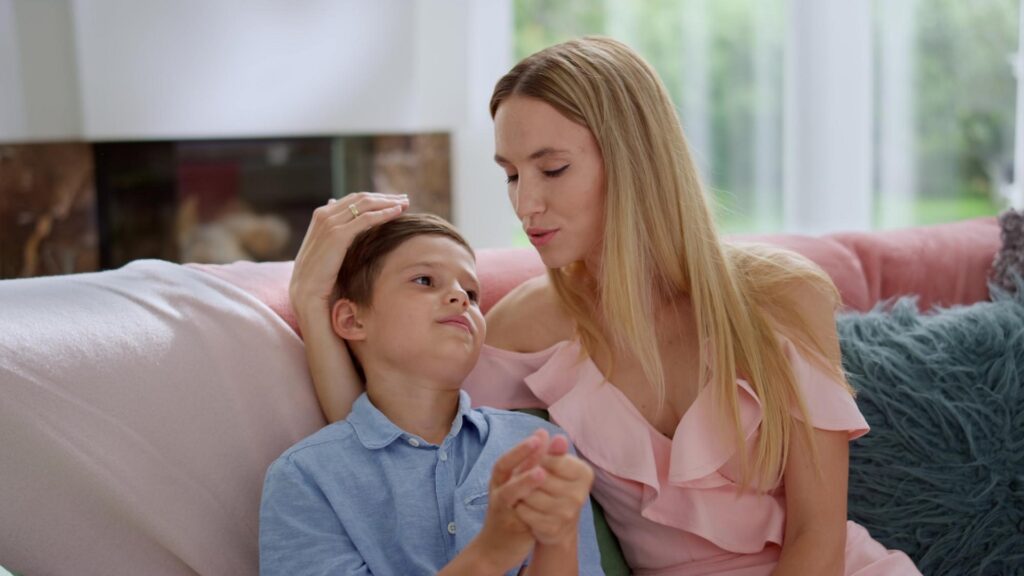Currently, Reactive Attachment Disorder (RAD) is the diagnosis associated with attachment impairment. There is little research available as to the prevalence of this disorder, but there are thousands of children who have been impacted by trauma and exhibit many of the symptoms that are part of the definition below. Some children are diagnosed with PTSD or other conditions instead of (or in addition to) RAD. The DSM-5 is slated to be published in 2013 and is likely to contain a much different definition of attachment disorders. For now, this is the official definition:
Definition from the DSM-IV 313.89: Reactive Attachment Disorder of Infancy or Early Childhood
Markedly disturbed and developmentally inappropriate social relatedness in most contexts, beginning before age 5 years, as evidenced by either (1) or (2):
persistent failure to initiate or respond in a developmentally appropriate fashion to most social interactions, as manifest by excessively inhibited, hypervigilant, or highly ambivalent and contradictory responses (e.g., the child may respond to caregivers with a mixture of approach, avoidance, and resistance to comforting, or may exhibit frozen watchfulness)diffuse attachments as manifest by indiscriminate sociability with marked inability to exhibit appropriate selective attachments (e.g., excessive familiarity with relative strangers or lack of selectivity in choice of attachment figures).
The disturbance in Criterion A is not accounted for solely by developmental delay (as in Mental Retardation and does not meet criteria for a Pervasive Development Disorder). Pathogenic care as evidenced by at least one of the following:
- persistent disregard of the child’s basic emotional needs for comfort, stimulation, and affection
- persistent disregard of the child’s basic physical needs
- repeated changes of primary caregiver that prevent formation of stable attachments (e.g., frequent changes in foster care)
There is a presumption that the care in Criterion C is responsible for the disturbed behavior in Criterion A (e.g., the disturbances in Criterion A began following the pathogenic care in Criterion C).
Specify type:
Inhibited Type: if Criterion A1 predominates in the clinical presentation
Disinhibited Type: if Criterion A2 predominates in the clinical presentation
What is Reactive Attachment Disorder?
Reactive Attachment Disorder (RAD) is a complex and often misunderstood condition that affects children’s ability to form healthy emotional bonds with caregivers. Although it’s a rare disorder, its impact on affected children and their families can be profound and long-lasting. With increased awareness and understanding of RAD, parents, caregivers, and professionals can work together to support children in overcoming this challenging disorder and help them build secure, loving relationships that last a lifetime.
Key Takeaways
- Reactive Attachment Disorder is a rare condition caused by emotional deprivation due to neglect, abuse and separation.
- Early recognition of symptoms in infants, young children and older kids is essential for providing tailored support interventions.
- Timely intervention is key to improving prognosis and avoiding long-term negative effects on development.
Understanding Reactive Attachment Disorder (RAD): Symptoms, Causes and Treatment
Reactive Attachment Disorder is a condition affecting children who struggle to form emotional bonds with caregivers due to neglect or abuse. Given a prevalence rate of 1-2%, early detection of RAD’s signs and symptoms becomes pivotal for parents, caregivers, and professionals. This helps them offer the right support and interventions that a child needs for developing healthy relationships and emotional well-being.
The causes of RAD can be traced back to the child’s history, specifically instances of severe neglect or abuse that hinder the development of secure attachments with caregivers. It is important to differentiate RAD from other conditions such as autism spectrum disorder, which may have similar symptoms but require different treatment approaches.
Reactive Attachment Disorder is a condition that can be challenging for both children and their caregivers. When a child has reactive attachment disorder diagnosed, it is crucial to seek the help of a mental health professional who will evaluate the child’s behavior and history. With reactive attachment disorder treated, treatment options often include therapy for both the child and caregiver, as well as special education services to address any developmental delays.
Definition and Prevalence
Reactive Attachment Disorder (RAD) is a rare condition in which children have difficulty forming emotional bonds with their caretakers due to inadequate care, such as neglect or abuse. The disorder is more prevalent among children who have experienced these adverse circumstances, particularly in institutional settings or in homes with unstable environments, such as foster care.
A clear understanding of RAD’s definition and prevalence enables us to identify affected children more efficiently and provide them with the support and interventions essential for their emotional development.
Inhibited RAD vs Disinhibited Social Engagement Disorder
Children with RAD may exhibit one of two primary types of attachment disorders: inhibited RAD or disinhibited social engagement disorder. Inhibited RAD is characterized by detachment and difficulty with emotional regulation, which may manifest as avoidance of eye contact, lack of response to comfort, and failure to seek comfort when distressed. On the other hand, disinhibited social engagement disorder is characterized by overly friendly behavior, such as displaying excessive friendliness with strangers, inability to recognize danger, and difficulty distinguishing between appropriate and inappropriate behavior.
Recognizing the differences between these two types of RAD is key to providing affected children with support and interventions that meet their unique needs. A nuanced understanding of inhibited and disinhibited RAD allows professionals and caregivers to address each child’s specific challenges more effectively, thereby helping them overcome obstacles and develop healthy relationships.
Identifying Symptoms of RAD
Symptoms of RAD, also known as reactive attachment disorder symptoms, can vary depending on the child’s age and the severity of their attachment disorder. Some common symptoms include:
- Fear
- Sadness
- Difficulty forming emotional connections with caregivers
- Inhibited behaviors, such as withdrawal
- Disinhibited behaviors, such as overly friendly interactions with unfamiliar people
Recognizing RAD’s signs and symptoms in young children diagnosed with the disorder, across different age groups, allows caregivers and professionals to intervene early and provide support, thereby improving outcomes for affected children.
Symptoms in Infants
Early warning signs of RAD in infants include unresponsiveness, absence of eye contact, and not smiling. Identifying attachment disorders in infants is critical, as early diagnosis can reduce the potential for more serious issues in the future.
Awareness of these signs in early childhood enables parents and caregivers to seek professional help and support promptly, thus providing their child with the best opportunity for healthy emotional development.
Symptoms in Young Children
A young child with RAD may exhibit fear, sadness, and difficulty forming emotional connections with caregivers. These challenges can be attributed to the child’s experiences of neglect or abuse, which have disrupted their ability to form secure attachments and hindered their emotional and social development.
If left untreated, RAD can have far-reaching implications, including difficulty forming connections, managing emotions, and performing in educational and professional settings. Early recognition and intervention are crucial for improving outcomes in young children with RAD.
Symptoms in Older Kids
Older children with RAD may exhibit inhibited or disinhibited behaviors, such as withdrawal or overly friendly interactions. These challenges can stem from the child’s early experiences of neglect or abuse, which have hindered their ability to form secure attachments and develop appropriate social and emotional skills, ultimately affecting the child’s behavior.
By recognizing the signs and symptoms of RAD in older children, caregivers and professionals can provide the necessary support and interventions to help them overcome these obstacles and foster healthy relationships.
Causes and Risk Factors
Reactive Attachment Disorder is thought to occur when a child is unable to form a secure bond with a parent or primary caregiver due to emotional deprivation. This can be a result of:
- Institutionalization
- Neglect
- Abuse
- Separation from parents
Research has indicated that there is an increased likelihood of Reactive Attachment Disorder in children who have experienced maltreatment.
It has been suggested that children may be more likely to develop RAD if they experience neglect or abuse, particularly in institutional settings or unstable homes. Adopting children without knowledge of their child’s history can prove difficult for even the most committed parents. Especially since unknown histories may include emotional instability, forming a bond between new family members can be more challenging.
Understanding RAD’s causes and risk factors equips us to better support affected children and their families in overcoming this challenging disorder.
Role of Neglect and Abuse
Neglect and abuse have a significant impact on the development of Reactive Attachment Disorder (RAD). Children who experience severe neglect or abuse are at a heightened risk of developing Reactive Attachment Disorder.
Research has also indicated that those who have been subjected to neglect and suffer from Reactive Attachment Disorder may be more likely to engage in substance abuse and other problematic behaviors during their teenage years. This highlights the importance of adolescents’ psychiatry in addressing these issues, as well as the potential impact of post traumatic stress disorder on the development of attachment disorders.
Addressing and preventing instances of neglect and abuse can help mitigate the risk of RAD in vulnerable children and enhance their chances for healthy emotional development.
Importance of Consistent Caregiving
Providing a stable, nurturing environment is essential for preventing RAD and promoting healthy attachment. The establishment of a secure and nurturing atmosphere is essential for averting RAD and fostering healthy attachment.
It is necessary to provide emotional engagement, physical affection, and mental support, which are fundamental for emotional and social development. Additionally, a stable and nurturing environment assists in reducing anxiety and promoting overall well-being for children with RAD, by providing them with a sense of security.
Diagnosis and Misdiagnosis
Diagnosing RAD involves assessing the child’s medical history, symptoms, and attachment behaviors, while ruling out other conditions such as autism. This is important because children with RAD may exhibit similar symptoms to other mental health conditions, which can lead to misdiagnosis and inappropriate treatment strategies.
Accurate diagnosis of RAD and its differentiation from other conditions enable professionals to ensure that affected children receive the right support and interventions tailored to their unique needs.
Diagnostic Criteria
Reactive Attachment Disorder diagnosis requires:
- A documented history of neglect or abuse
- A child displaying a sad or fearful demeanor that is not responsive to their caregiver
- The exclusion of other possible conditions
- The child must have achieved a developmental age of at least 9 months
Only then can a diagnosis be made.
By understanding the diagnostic criteria for RAD, professionals can accurately identify the disorder and provide the appropriate support and interventions needed for the child’s emotional development.
Misdiagnosis Concerns
RAD can often be mistaken for other disorders, such as:
- Depression
- Anxiety
- ADHD
- Oppositional defiant disorder
- Conduct disorder
- Genetic or neurological disorders
- Autism spectrum disorder
It is important to accurately diagnose RAD in order to effectively treat it. It is essential to rule out other conditions, including autism, in order to make an accurate diagnosis of RAD.
Misdiagnosis of mental illness can lead to inappropriate treatment strategies and may hinder the child’s progress in developing healthy emotional bonds and relationships.
Treatment Approaches
Treatment for RAD includes therapy for both the child and caregiver, as well as special education services to address developmental delays.
Providing comprehensive support and interventions tailored to a child’s unique needs allows professionals to help children with RAD develop healthy relationships and improve their emotional well-being.
Therapy for Child and Caregiver
Family therapy, play therapy, and behavioral management training have been shown to be effective in helping children with Reactive Attachment Disorder develop appropriate relationships and emotional regulation skills. Attachment-based family therapy is utilized to strengthen the connection between the child and their family members, helping to foster a secure and supportive environment for the child’s emotional development.
Play therapy for Reactive Attachment Disorder involves the utilization of gameplay or toys to promote parent-child bonding, allowing the child to express their emotions and develop a deeper connection with their caregiver.
Behavioral management training for RAD involves:
- Establishing a system of appropriate rewards and punishments for specific behaviors
- Reducing the occurrence of unwanted behaviors
- Promoting positive, healthy interactions between the child and their caregiver.
Special Education Services
Special education services for Reactive Attachment Disorder (RAD) may include enhancing school and parent communication, implementing social skills intervention, and offering special education services tailored to the child’s needs.
By providing specialized instruction and support for children with RAD, professionals can help them overcome learning and social challenges, enabling them to reach their full potential in both academic and social settings.
Prevention Strategies
Preventing RAD involves providing a stable, nurturing environment and consistently meeting the child’s basic needs for comfort, affection, and nurturing.
When children receive the love, support, and consistency they require, parents and caregivers can help prevent the development of RAD and foster healthy emotional growth.
Stable and Nurturing Environment
Ensuring a safe, loving, and consistent caregiving environment can help prevent RAD and promote healthy attachment. A stable and nurturing environment not only provides a sense of security for children with RAD, but also assists in reducing anxiety and promoting overall well-being.
By creating a supportive atmosphere in which children feel valued and cared for, parents and caregivers can help them develop secure attachments and foster healthy emotional development.
Parenting Tips
Parents can support their child’s emotional development by being responsive, patient, and consistent in their caregiving approach. This involves remaining attentive to their child’s needs, providing consistent and predictable care, and maintaining patience and understanding when their child or her primary caregivers are having difficulty.
By adopting a compassionate and consistent caregiving approach, parents can help their child overcome the challenges associated with RAD and foster healthy emotional growth.
Long-term Consequences and Prognosis
Untreated RAD can lead to lifelong issues, such as:
- difficulties in forming relationships
- difficulties with social interactions
- mental and physical health concerns
- behavioral issues
- intellectual development deficits
- substance abuse
However, with early intervention and appropriate treatment, children with RAD can foster healthy relationships and enhance their emotional health, although the duration of recovery may vary. Recognizing the importance of early intervention and treatment is crucial for improving outcomes for children with RAD.
Untreated RAD
Children with untreated RAD may face ongoing emotional, behavioral, and relationship challenges throughout their lives. These difficulties can have a profound impact on their overall well-being, hindering their ability to form secure attachments and develop healthy relationships.
Recognizing the long-term consequences of untreated RAD can help parents and caregivers understand the importance of seeking appropriate intervention and support for their child.
Treatment Outcomes
With appropriate treatment, children with RAD can develop healthy relationships and improve their emotional well-being, although recovery timelines may vary. Timely and effective intervention is crucial in helping affected children overcome the challenges associated with RAD and foster secure, loving connections with their caregivers and others in their lives.
Providing the necessary support and interventions enables caregivers and professionals to help children with RAD reach their full emotional potential.
Summary
Reactive Attachment Disorder is a rare but impactful condition affecting children’s ability to form healthy emotional bonds with caregivers due to neglect or abuse. By understanding the symptoms, causes, and treatment options for RAD, parents, caregivers, and professionals can work together to support affected children in overcoming this challenging disorder. Early intervention, appropriate treatment, and a stable, nurturing environment are crucial for ensuring the best possible outcomes for children with RAD. Together, we can help these children build secure, loving relationships that last a lifetime.
Frequently Asked Questions
What are signs of reactive attachment disorder?
Signs of reactive attachment disorder include difficulty forming emotional attachments to others, decreased ability to experience positive emotions, lack of acceptance of physical or emotional closeness, and violent reactions when held, cuddled, or comforted.
These signs can be difficult to recognize, as they may be subtle or even absent in some cases. It is important to be aware of the signs and to seek professional help if you suspect that your child may be suffering from reactive attachment disorder.
What are the two types of reactive attachment disorder?
Reactive attachment disorder is composed of two main types: inhibited and disinhibited. These are characterized by different behaviors in early childhood, such as not responding to comfort or clinging to strangers.
Inhibited reactive attachment disorder is characterized by a child not responding to comfort or affection from caregivers. They may also appear emotionally withdrawn and avoid physical contact.
Is reactive attachment disorder similar to autism?
Reactive Attachment Disorder and Autism share some overlapping difficulties with social relationships, but it is important to note that RAD is usually associated with neglect or maltreatment while ASD is not.
Clinicians must be aware of the nuanced differences between the two diagnoses when making an accurate differential diagnosis.
What does reactive attachment disorder look like at school?
Students with Reactive Attachment Disorder may be overly controlling and argumentative, leading to frequent classroom disruptions and power struggles with teachers.
These behaviors can be difficult to manage, as they are often rooted in a child’s underlying emotional needs. Teachers must be aware of the underlying causes of these behaviors and be prepared to respond in a way that is both supportive and supportive.
What are the main symptoms of Reactive Attachment Disorder?
Reactive Attachment Disorder is characterized by symptoms such as fear, difficulty forming connections with caregivers, withdrawal, and overly friendly interactions with strangers.







